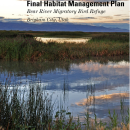What We Do
Wildlife conservation is at the heart of the National Wildlife Refuge System. It drives everything on U.S. Fish and Wildlife Service lands and waters managed within the Refuge System, from the purposes for which a national wildlife refuge national wildlife refuge
A national wildlife refuge is typically a contiguous area of land and water managed by the U.S. Fish and Wildlife Service for the conservation and, where appropriate, restoration of fish, wildlife and plant resources and their habitats for the benefit of present and future generations of Americans.
Learn more about national wildlife refuge is established to the recreational activities offered to the resource management tools used. Using conservation best practices, the Refuge System manages Service lands and waters to help ensure the survival of native wildlife species.
Refuge staff use a variety of habitat management techniques to maintain, recover, or enhance plant and wildlife values. Management techniques are carefully considered and employed in varying degrees according to needs.
Water levels are carefully monitored and controlled to foster desired plant growth. Sometimes, sensitive areas are closed to the public so that the land can recover more quickly. Predator control is conducted on the Refuge to protect nesting birds and enhance their nesting success. Prescribed burning, mowing, and seeding are also some techniques used to help native plants recover on the Refuge.
Standardized ground and aerial wildlife and vegetation surveys are conducted on Refuges throughout the year to inventory populations and document habitat use. Units are evaluated by how well they met habitat and wildlife use objectives.
Bear River Refuge staff set habitat objectives by linking ecological and physical aspects of Refuge lands with priority species requirements. Objectives concisely state habitat conditions needed for priority species. Finally, Refuge staff use ecological data, scientific literature, expert opinion, key historical Refuge data, and staff expertise to generate a list of potential management strategies for each habitat type. The most appropriate management strategy is selected each year during the annual habitat management process. The strategy selection is based on the effect of management on habitat and species of concern from the previous year, as captured through monitoring, as well as on the predicted water supply of the Bear River for the coming year.
Management and Conservation
Refuges deploy a host of scientifically sound management tools to address biological challenges. These tools span active water management to wilderness character monitoring, all aimed at ensuring a balanced conservation approach to benefit both wildlife and people. Bear River Migratory Bird Refuge is one of hundreds of refuges that use non-recreational trapping as a management tool. Bear River MBR conservation toolbox also includes:
- Planning - Habitat Management Plan 2021
- Habitat Restoration
- Agriculture
- Climate Resilience
- Conservation Easements
- Compatibility Determinations
- Contaminants Mitigation
- Education and Outreach
- Fire Management
- Grazing
- Human Dimensions
- Invasive Species Management
- Inventory and Monitoring
- Land Acquisition
- Law Enforcement
- Recreation Management
- Species Research
- Trapping (Non-recreational)
- Water Management
Our Services
At this field station we offer the following public services:
- Purchase Duck Stamps and Junior Duck Stamps through the Friends of Bear River Refuge Bookstore
- Cooperative Agriculture - Bear River Migratory Bird Refuge has cooperative agricultural opportunities that help the Refuge manage invasive phragmites. If you are interested in more information about these opportunities, please contact Mike Dunphy at bearriver@fws.gov or 435-723-5887.
- Grants or Funding Opportunity
- Habitat Planning and Management
- Landowner Incentives
- Photo Blinds
- Photo Contests through the Friends of Bear River Refuge
- Special Use Permit
- Special Use Permit - Research
- Special Use Permit - Commercial Photography
Law Enforcement
U.S. Fish and Wildlife Service law enforcement officers have a wide variety of duties and responsibilities. Officers help visitors understand and obey wildlife protection laws. They work closely with state and local government offices to enforce federal, state, and Refuge hunting regulations that protect migratory birds and other game species from illegal take and preserve legitimate hunting opportunities. Some other duties include patrolling closed areas or Wilderness areas, maintaining relationships with neighboring landowners, maintaining Refuge boundaries, and participating in public events related to Refuge issues.
- Please check with refuge management before participating in an activity that could harm the environment or yourself. Be safe and enjoy your national wildlife refuge national wildlife refuge
A national wildlife refuge is typically a contiguous area of land and water managed by the U.S. Fish and Wildlife Service for the conservation and, where appropriate, restoration of fish, wildlife and plant resources and their habitats for the benefit of present and future generations of Americans.
Learn more about national wildlife refuge . - Law enforcement issues should be referred to the refuge manager.
- You may also report violations to FWS TIPS line at 1-844-FWS-TIPS (1-844-397-8477).
Laws and Regulations
Bear River Migratory Bird Refuge was established by Congress by Public Law 304 in 1928. Since that time many other Congressional laws guide our management and legal obligations to our original foundation for migratory wild fowl and their lifecycle needs.
